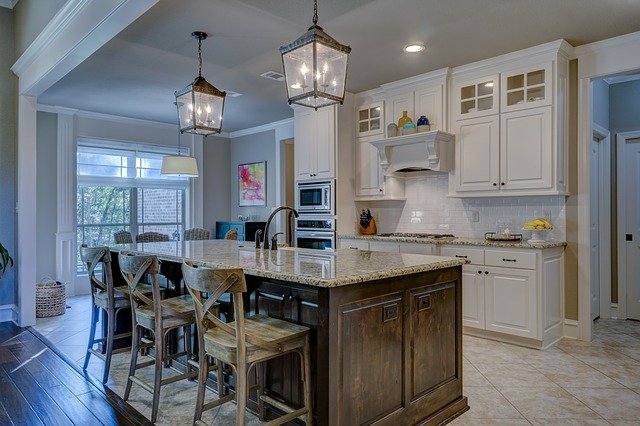Investing in a quality kitchen countertop is the first step towards making your kitchen renovation successful. Thankfully, you have a wide range of countertop materials to choose from—there are even recycled glass countertops available now. Check out this URL to learn more. Irrespective of your budget or décor needs, there is a perfect countertop material for you. Each countertop material has its distinctive properties, with advantages and some disadvantages. In this article, we will discuss some of these to help you make an informed decision.
Laminate Countertops
This material offers an elegant stone-like look minus the high cost. Laminate countertops are made using multiple layers of thin paper sheets joined together using epoxy or special glue. These paper sheets are made using different patterns to create various appearances. A laminate worktop will cost you between $30 and $50 per square foot. The cost can go higher based on the quality of the material.
Pros
- Laminate material comes in a range of design patterns.
- It fits in both traditional and contemporary spaces.
- The material is both scratch and heat resistant, making it durable.
- It is non-porous and antibacterial, which makes it easier to clean and maintain.
Cons
- If you fail to maintain it, the material will peel.
- If exposed to extremely hot temperatures, it can melt or burn.
- You will not get the shine that other materials have.
Marble
Marble is a natural stone that encompasses calcite or carbonite materials. They are mainly found in light colors that feature natural stress lines or veins across its body. Marble countertops are ideal for kitchen, bathrooms, powder rooms, etc., and add a touch of luxury to space. Marble is a relatively expensive material, which can cost between $50 and $250 per square foot based on the quality and design.
Pros
- Marble effortlessly blends with most base colors.
- It offers an elegant appeal to any countertop.
- Marble is highly water-resistant.
- The surface remains cool all the time.
Cons
- You need to use sealant more frequently to keep the surface properly covered and keep it clean.
- If marble is exposed to hot water often, it will wear over time
- Marble is a softer stone that is more prone to chipping
Granite
Granite is the most common kitchen countertop, owing to its strength and durability. It is basically magma that has been pressurized for many years to create a rock. Granite is heat and scratch-resistant, which makes it an ideal material for the kitchen countertop. When granite is installed, it is sealed, making it stain-resistant for an entire life.
For the most part, it has a lighter tone with tons of dark spots all over it. Along with being a sturdy material, it is extremely easy to clean. And you will find granite has a wide range of color options. Granite would cost you around $50 to $100 per square foot.
Pros
- Granite is highly heat resistant, making it great for the kitchen.
- It is sealed when installed, thereby providing stain resistance.
- Granite is antibacterial, making it easier to clean and maintain proper hygiene.
Cons
- Granite is very heavy, so it cannot be placed over surfaces or cabinets that are lightweight or too weak.
Quartzite
It is a type of quartz that has been turned new through heating. Quartzite looks quite similar to conventional quartz, but it is light in color. During the making of this material, added compression is used to form a stronger body that is more thorough. Additionally, this material can handle various situations, making it suitable for the kitchen environment. And the pressure also reduces the pored, which makes it easier to maintain the countertop. This will cost you between $50 and $100 per square.
Pros
- Quartzite has a firmer body and is easier to maintain than traditional quartz material.
- The material is easy to clean.
- It comes in a lot of light tones.
Cons
- You will have to seal it regularly to protect its natural appearance.
- It is vulnerable to scratch.
Engineered Quartz
Engineered quartz is similar to granite with regard to properties and appearance. But it provides a more consistent look when it comes to style. Additionally, this material is made using natural quartz and resin. This way, you get a material that is strong and can handle a lot of fatigue.
However, engineered quartz needs additional processing to get prepared. The cost of the engineered quartz depends on the manufacturing quality. You will find this material anywhere between $50 and $89 per square foot.
Pros
- The material comes in a wide range of color options.
- It is an antibacterial surface that is easy to clean.
Cons
- You may not always get the right quality of quartz.
- It is quite heavy.
Solid Surface
A solid surface countertop is designed using a series of acrylic and polyester materials. You will find this material in a wide range of color options. Another great thing about solid surfaces is that they have invisible seams, and you can choose from a wide range of edge profiles. You can also choose a color based on your surface, making it fully customizable. For a solid surface countertop material, you will be shedding anywhere between $45 and $75 per square foot.
Pros
- It has a smooth and non-porous surface which is easier to clean.
- The damage that is developed on the material can be buffed and sanded.
- It is a versatile surface that is used for various applications.
Cons
- The solid surfaces are vulnerable to scratches.
- Exposure to heat can cause discoloration and open the seams.
Wood
The wood that you use on the flooring can be used on the countertop. Hardwood offers a relaxed style, peace of mind and boosts the overall appeal of your space. You will find wood material with a lot of colors and grains. Wood countertops can cost you around $20 to $150 per square foot.
Pros
- It will not stain or scratch that easily.
- You can get wood in both lighter and darker tones.
- It does not lose its beauty or charm over time.
Cons
- You have to oil it every two years to prevent stains and damages.
The Bottom Line
There you have it, some of the popular countertop materials and their comparison. Now you can choose the one that is suitable for you based on your budget and décor requirements.




